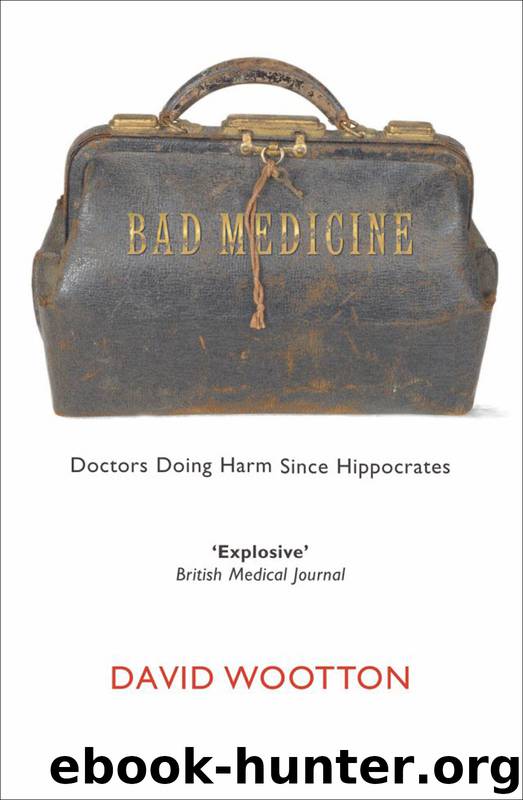Bad Medicine: Doctors Doing Harm Since Hippocrates by David Wootton

Author:David Wootton [Wootton, David]
Language: eng
Format: epub
Tags: History, General, Medical, Science
ISBN: 9780199212798
Google: 6pMSDAAAQBAJ
Publisher: Oxford University Press
Published: 2007-11-22T01:25:48+00:00
26. A set of Perkins tractors.
Haygarth also noticed a small number of cases in which patients got worse not better when the fictitious tractors were applied: thus he showed that imagination could cause as well as cure diseases. In such cases, we might say, the symptoms Haygarth was producing in his patients were psychosomatic in origin; but Haygarth did not pursue this line of thinking. More importantly, he did not reverse it: he did not claim that the symptoms that were cured by fictitious tractors were psychosomatic. This is important because doctors had known since ancient times that emotions could give rise to physical symptoms and that these symptoms could be cured by a change in the patient’s emotional state. Edward Jorden in 1603, for example, had discussed the case of a young man who had fallen out with his father and then fallen victim to ‘the falling sickness’ (epilepsy): he had been cured by a kind letter from his father. Haygarth did not argue that the fictitious tractors only worked to cure conditions that were psychological in origin.
Haygarth believed that his experiments with fictitious tractors explained why a famous doctor was often more successful in his practice than someone without an established reputation, and why a new medicine was often more successful when it was first introduced than when it had been around for some time. One doctor or one medicine might be more successful than another because they were more effective in eliciting the cooperation of the patient’s imagination. For real success, he claimed, it was important that both the doctor and the patient should be believers: ‘Medical practitioners of good understanding, but of various dispositions of mind, feel different degrees of scepticism in the remedies they employ. One who possesses, with discernment, the largest portion of medical faith, will be undoubtedly of greatest benefit to his patients.’
Here Haygarth’s conclusion was at odds with his own research. He had successfully shown that sceptics, using fictitious tractors, could, by pretending to believe, elicit results indistinguishable from those achieved by true believers using genuine Perkins tractors. His doctors had cynically used the patter employed by the advocates of the Perkins tractor, without believing for a moment what they were saying. Why pretend otherwise? One can only assume that Haygarth wanted to protect himself against the charge of encouraging lying and hypocrisy when he asserted, against the evidence of his own trials, that if one wants to touch one’s patient’s heart one must speak what one feels.
But what Haygarth had done was suggest that much standard medicine relied entirely on the placebo effect. Within a few years the arguments he had deployed to explain the apparent success of Perkins tractors were to be employed by his medical colleagues to explain the success of homeopathy. Oliver Wendell Holmes’s essay on ‘Homeopathy and its Kindred Delusions’ (1842) contains an extended discussion both of the Perkins tractors and of Haygarth’s fictitious tractors. But the genie was out of the bottle. If the placebo effect
Download
This site does not store any files on its server. We only index and link to content provided by other sites. Please contact the content providers to delete copyright contents if any and email us, we'll remove relevant links or contents immediately.
| Administration & Medicine Economics | Allied Health Professions |
| Basic Sciences | Dentistry |
| History | Medical Informatics |
| Medicine | Nursing |
| Pharmacology | Psychology |
| Research | Veterinary Medicine |
The Immortal Life of Henrietta Lacks by Rebecca Skloot(4525)
An American Plague by Jim Murphy(3710)
The Emperor of All Maladies: A Biography of Cancer by Siddhartha Mukherjee(3064)
The Gene: An Intimate History by Siddhartha Mukherjee(3047)
The Fate of Rome: Climate, Disease, and the End of an Empire (The Princeton History of the Ancient World) by Kyle Harper(3003)
Rebecca Skloot by The Immortal Life of Henrietta Lacks(1978)
Stiff - The Curious Lives of Human Cadavers by Mary Roach(1814)
The Great Influenza by John M Barry(1750)
The Vaccine Race by Meredith Wadman(1627)
Undue Risk by Moreno Jonathan D.;(1600)
Hero by Michael Grant(1584)
Three Cups of Tea by Greg Mortenson(1576)
The Mystery of the Exploding Teeth by Thomas Morris(1539)
Quackery by Lydia Kang(1519)
Autism's False Prophets by Paul A. Offit(1495)
Extremes: Life, Death and the Limits of the Human Body by Fong Kevin(1484)
A Journal of the Plague Year (Oxford World's Classics) by Daniel Defoe(1480)
Steroids: History, Science, and Issues by Standora Joan E.; Bogomolnik Alex; Slugocki Malgorzata(1479)
The Vaccine Court by Rohde Wayne(1471)
